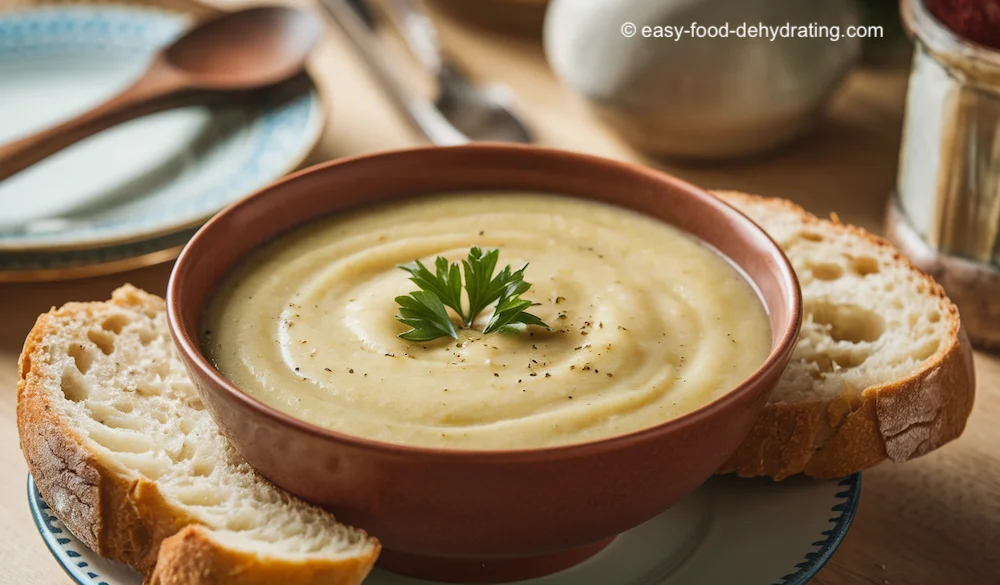What We Mean by “Dehydrate”
Here at Easy Food Dehydrating, “dehydrate” always means using an electric food dehydrator — the easy, reliable way to dry food at home.
- Home
- Easy Dehydrated Food Recipes
- Celery and Potato Soup Recipe
Celery and Potato Soup –
Warm Up with a Cozy Bowl!

Warm, cozy, and surprisingly simple—this Celery and Potato Soup is proof that you don’t need a long ingredient list to create comfort in a bowl. Made with just three pantry-friendly veggies (potatoes, celery, and onion), it’s hearty enough for dinner yet light enough for lunch.
✅ Quick Answer: How do you make celery and potato soup?
To make celery and potato soup, simmer potatoes, celery, and onion in vegetable stock with herbs until tender, then blend until smooth or leave chunky. It’s a simple, hearty, and budget-friendly soup you can make with fresh or dehydrated ingredients.
I often prepare it with dehydrated vegetables, which makes it a year-round staple, but you can just as easily swap in fresh produce. Whether you prefer it smooth and creamy or rustic and chunky, this soup will keep you satisfied and warm.

The soup in my photo is fully blended, but if you like a chunkier texture, blend just a portion of it to thicken it, then stir it back in.
If you have fresh ingredients on hand, please scroll down below the recipe to see the swap.

Celery and Potato Soup Recipe
Ingredients
- 2 cups dehydrated potatoes
- 1 cup dehydrated celery
- 1/4 cup dehydrated onion
- 2 cups boiling water to re-hydrate items above
- salt* and pepper to taste
- 4 cups of vegetable stock
- 1/2 teaspoon Cumin
- 2 tablespoons fresh chopped parsley (or 1 teaspoon dried)
- 1/4 teaspoon Tarragon
- 1/4 teaspoon Celery Salt
Instructions
- Use the freshly boiled water to rehydrate the dehydrated items above.
- When they are sufficiently plump, put the veggies into a heavy saucepan, toss the excess water, and add the vegetable stock to the pan.
- Add the chopped parsley, tarragon, celery salt, and cumin. Bring to a boil and simmer for about 30 minutes, or until the vegetables are fully cooked/soft.
- Use a blender to mix in small batches... allow the air to escape from the little hole in the lid so that the heat doesn't cause any explosive problems! Just have your hand over that top little hole to catch any runaway splashes.
- Blend until smooth, about 45 - 60 seconds.
*IF you need to add salt, do so, BUT be careful NOT to over-salt as the bouillon has salt in it.
Nutrition Information
- Servings: 6 servings
- Calories: 94kcals
- Fat: 0.2g
- Protein: 1.8g
- Carbohydrates: 21.5g

Using Fresh Ingredients Instead of Dried
If you want to use fresh ingredients that you may have on hand, do this:

Exchange the dry ingredients in the recipe, above, for these fresh ingredients listed below!
- 3 medium potatoes, washed, peeled, and sliced
- 3 celery stalks, sliced
- 1/2 large onion, peeled and diced
What to Serve with Celery and Potato Soup
This soup pairs beautifully with crusty bread, garlic toast, or a simple green salad.
For a heartier meal, serve alongside roasted chicken or a grilled cheese sandwich.
Leftovers make a quick lunch the next day!
20 Taste-Tested Easy Recipes
🍕 Pizza! 🥧 Shepherd's Pie! 🥘 Beef Stew! plus
Cauliflower Soup and Cauliflower Mash, along with crazy Carrot Soup!
Decadent Desserts: Carrot Cake and Cranberry Pineapple Pie!
and more...
Fresh food ingredient amounts are included for when you have fresh food on hand.
See which recipes are included here.
Curried Celery & Potato Soup: A Flavor Twist
This is a mild-tasting, tummy-filling soup. It's easy to make and everyone loves it! If you prefer NOT to put it in the blender for a smooth soup, go ahead and leave it lumpy!
If you look at the curried version (the link takes you to the full recipe), you'll see that I didn't blend the soup... (I might have been in a hurry that day!)
Whatever the reason was for not blending it after making it, it still tasted great!
Other Variations to Try
Want to mix things up? Add leeks for a sweeter flavor, stir in spinach for extra greens, or swirl in cream for a richer texture.
For a smoky touch, a pinch of paprika or a dash of liquid smoke works wonders.
Celery & Potato Soup FAQs (Your Questions Answered)
Can I make celery and potato soup without blending it?
Can I make celery and potato soup without blending it?
Yes! If you prefer a chunky texture, simply mash part of the soup with a fork or potato masher and stir it back in, leaving the rest hearty and rustic.
What herbs go best with celery and potato soup?
What herbs go best with celery and potato soup?
Tarragon, parsley, cumin, and celery salt enhance the flavor beautifully. You can also add thyme or bay leaves for an earthier taste.
Can I freeze celery and potato soup?
Can I freeze celery and potato soup?
Absolutely. Let the soup cool completely, then store in airtight containers for up to 3 months. Reheat gently on the stove and stir well.
How can I make this soup more filling?
How can I make this soup more filling?
Add cooked ham, chicken, or beans for extra protein. A swirl of cream or shredded cheese on top also makes it richer and more satisfying.
Thanks so much for visiting and checking out my celery and potato soup!
If you enjoyed this recipe, you’ll love my free 5 Dried Food Recipes You'll Actually Love PDF. Inside, you’ll find my top favorites: carrot soup, minestrone, split pea soup, spicy beef jerky, and banana cinnamon rolls. They’re easy, tasty, and pantry-friendly—perfect for adding variety to your meal plan.
Get 5 Dried Food Recipes You'll Actually Love
Here's where you can get your copy of our all new
5 Dried Food Recipes (That Actually Taste Great)
They're my all-time favorite easy dried food meals!
Get it here right now.
For Free!
Before You Go...
If you enjoyed this page, tap the ❤️ in the lower right-hand corner.
It saves this page to your Grow bookmarks so you can find it again later.
You’ll also see quick share buttons to copy the link, post to Facebook,
or save it straight to Pinterest.



















